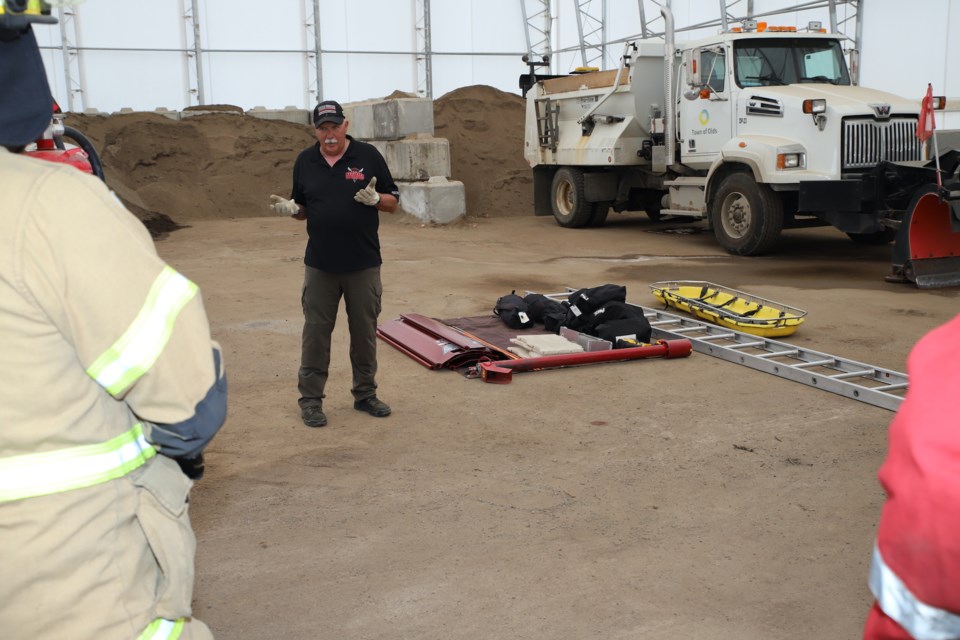OLDS — You’ve got to think and be strategic before you try to rescue a person trapped in a pile of grain, a group of firefighters and rescue personnel gathered in Olds were told.
Bill McCombs of Trans-Care Rescue Ltd., a rescue training and supply company in Langham, Saskatchewan, made that point during a grain entrapment seminar.
It was one of several rescue scenarios staged during the 2023 Western Canada Advanced Rescue Symposium in Olds.
About 160 firefighters and rescue personnel from as far away as B.C. attended the symposium, held June 22-25 at the fire training centre near the town’s northwestern limits.
“If somebody is caught in there, that’s a big challenge. And it happens every now and then,” he said.
“(If the grain is) up to his waist, up to his shoulders or whatever, (there’s a) real great chance of survival. If we work quickly, we do things properly, we can get the guy out,” he said.
However, McCombs said those endeavouring to rescue that trapped person can’t just climb into the bin to get that person out. There’s a lot more to it.
They’ve got to think carefully.
First of all, he said, all the electrical systems interacting with the grain bin – including the auger, but not including the ventilation system -- have to be shut off.
“We don’t want to have the neighbour come over and go, ‘if we turn the auger on, he would out the bottom.’ Yes he will. And you’ll get a hand and you’ll get another part. You don’t want that to happen,” McCombs said.
He said keeping the ventilation system on will ensure there’s fresh air going though the grain pile, keeping the victim alive.
Rescuers should also be careful what kind of ladder they climb up to get into the bin.
If it’s a cage ladder, avoid it.
“If you fall, it guarantees you’re going to land, kind of right down here; you’re just not in the same configuration you were when you started out, because it’s a cheese grater. It just beats the heck out of people,” McCombs said.
Once a safe ladder up into the bin is in place, rescuers need to be strapped into a three-point harness to ensure they’re tied up safely.
“All the way up, you’re tied off 100 per cent. If you fall, you go back like this, you go, ‘ooh, might have to go for a change of pants like this, but I’m OK,’” McCombs said.
Always wear a helmet with a chin strap and make sure that strap is fastened in place.
“You get 50, 60 feet in the air and wind is common, so all of a sudden, there goes your helmet. Or you bend over, look in the bin and – whoops,” he said.
McCombs told the group about a time a guy’s helmet came off and hit a victim, causing a cut that required eight stitches to close.
He also advised the group to wear good thick gloves, because the bins are literally made of tin and can be very sharp in places.
Once people ready to actually go into the bin to rescue the trapped person, McCombs suggested using probes just like people rescuing people covered in avalanches do, so that the person’s extremities can be located.
“We need to know where his legs are,” he said, adding that naturally, the trapped victim struggles to push him or herself out of that grain pile.
McCombs demonstrated another key aspect of the rescue process: setting up a series of metal slats around the rescuee.
The slats are designed to go around the person in an octagonal shape because the grain continually surrounds and pushes against the victim.
When in place, the slats provide space between the victim and the grain so they can breathe.
“Every time I inhale, my diaphragm moves and now I’ve got this weight issue,” McCombs said. “And if that continues on and I keep packing it, pretty soon my diaphragm is barely moving.”
He also told the group to prepare for the fact that the victim is yet more weight they will have to allow for as they go about the rescue process.
After demonstrating equipment on the floor, a person was placed in a simulator and attendees were shown the basics of how to safely remove that person.
But McCombs said rescue from grain is an extremely complicated situation, as is the condition of the person once removed from there, so he recommended that attendees take a more comprehensive course on the subject.



